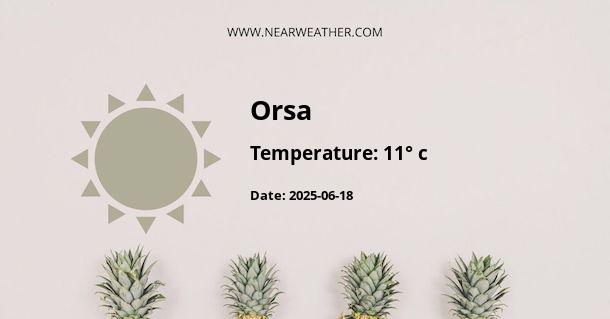Climate and Weather in Orsa, Sweden
Orsa, located in Sweden, experiences a subarctic climate characterized by long, cold winters and short, mild summers. The climate in this region is greatly influenced by its high latitude and proximity to the Arctic Circle. In this article, we will explore the weather conditions in Orsa throughout the year, including temperature variations, precipitation levels, and seasonal changes.
Temperature
Orsa has a significantly cold climate, with average temperatures below freezing for a large part of the year. Winters in Orsa are particularly harsh, with temperatures often dropping well below zero. In January, the coldest month, average temperatures range from -14°C (7°F) to -7°C (19°F). Frost and snow are common during this season, creating a picturesque winter landscape.
Summers in Orsa are relatively short but pleasant. The warmest month is July, with average temperatures ranging from 13°C (55°F) to 22°C (72°F). Although the temperatures are not extremely high, the region experiences long daylight hours during the summer months due to its high latitude. This provides ample opportunity for outdoor activities and exploration.
It is important to note that these temperature ranges are averages, and actual temperatures in Orsa can fluctuate. It is always recommended to check the local weather forecast before planning any outdoor activities.
Precipitation
Orsa receives moderate levels of precipitation throughout the year, with a slightly higher amount during the summer months. The annual average precipitation in Orsa is around 600mm (23.6 inches). Rainfall is fairly evenly distributed throughout the year, although it is slightly higher during the summer months.
During the winter, precipitation in Orsa is predominantly in the form of snow. The region experiences frequent snowfall, resulting in a snowy landscape that adds to the charm of the area. Snow cover can be expected from November to March, with the highest depths occurring in January and February.
Seasonal Changes
Orsa, like many other locations in Sweden, experiences distinct seasonal changes throughout the year. These changes bring unique characteristics and activities to each season.
Spring (March to May): Spring in Orsa is a transitional period, with temperatures gradually rising and the snow melting. The landscape starts to come alive with the blooming of flowers and the return of wildlife. It is an excellent time for hiking and exploring the surrounding nature.
Summer (June to August): Summer in Orsa is relatively short but pleasant. The region experiences longer daylight hours, allowing for extended outdoor activities. Visitors can enjoy hiking, fishing, and exploring the beautiful Orsa Grönklitt Wildlife Park.
Autumn (September to November): Autumn in Orsa is characterized by colorful foliage as the leaves change to vibrant shades of red, orange, and yellow. The temperatures start to drop, and the region prepares for the upcoming winter season. It is a great time for photography and enjoying the scenic beauty of the surroundings.
Winter (December to February): Winter in Orsa is a magical time, with snow-covered landscapes and opportunities for winter sports. The region offers excellent skiing and snowboarding conditions, making it a popular destination for winter enthusiasts. The Orsa Bear Park is also a must-visit during this season.
Conclusion
Orsa, Sweden experiences a subarctic climate with long, cold winters and short, mild summers. The temperature ranges from below freezing in winter to mild temperatures in summer. Precipitation is moderate throughout the year, with snowfall being prominent during winter. The distinct seasonal changes bring unique experiences and activities, making Orsa an attractive destination for nature lovers and winter sports enthusiasts.
A - Orsa's Latitude is 61.120338 & Longitude is 14.615500.
A - Weather in Orsa is -7° today.
A - Climate Conditions in Orsa shows scattered clouds today.
A - Humidity in Orsa is 89% today.
A - Wind speed in Orsa is 9.25 km/h, flowing at 260° wind direction. today.
